Fitosporin-M: instructions for use, tips and rules for using powder, paste and liquid
To protect plants from diseases, it is best to use biological products, because they are very effective and, most importantly, environmentally friendly.
Fitosporin is a time-tested bio-fungicidal agent, which has been proven by numerous reviews of both amateur gardeners and experienced biologists.
Next, we will consider in detail for which crops and against which diseases Fitosporin-M is effective, as well as instructions for its use: preparation of a working solution and methods of processing.
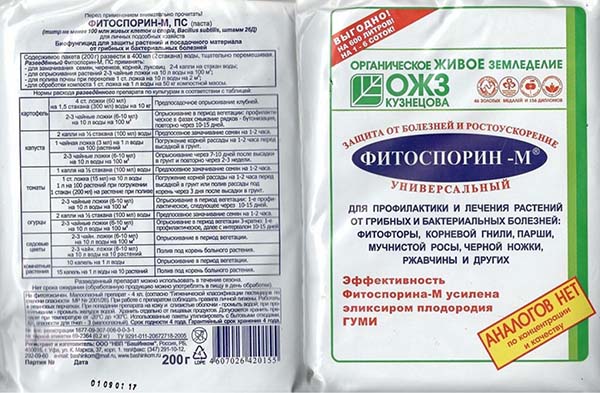
Content
- 1 What is Fitosporin-M: description of the drug and release form
- 2 Areas and purposes of using Fitosporin-M: what it is used for
- 3 How to prepare Fitosporin-M solution: instructions for use
- 4 Fitosporin-M powder: how to prepare a solution and apply correctly
- 5 Fitosporin-M liquid: how to prepare a solution and apply correctly
- 6 Fitosporin-M paste: how to prepare a solution and apply correctly
- 7 Can Fitosporin be mixed with other remedies
- 8 Precautions when working with the drug
- 9 Conditions and shelf life of the drug
What is Fitosporin-M: description of the drug and release form
Fitosporin M is a biological preparation for plant protection and prevention of fungal and bacterial diseases.
IN Fitosporin contains:
- the titer of live spores and cells is not less than N million / g, Bacillus subtilis (Hay bacillus), strain 26 D;
- elixir of fertility Gumi.
Specialized types of Fitosporin (Cabbage, Potatoes, Cucumbers, Tomatoes, Garden Flowers) contain specially selected (selected) bacteria against specific diseases, as well as important trace elements.
Fitosporin-M is available in the following forms:
- powder (light white);
- in the form of a paste (dark color);
- liquid (smells like ammonia and is usually used for indoor plants).
You can also find Fitosporin in the form of a nano-gel.
Areas and purposes of using Fitosporin-M: what it is used for
Worth knowing! Biologicals are softer than chemistry, because they not only suppress the infection, but also increase the immunity of the plant, i.e. the ability of the plant to resist disease itself. And this, as you know, is much more important, since it is impossible to suppress all infections.
Fitosporin can be used for:
- soil disinfection;
- pre-planting seed soaking and tubers treatment;
- soaking the roots of seedlings when planting in the ground;
- watering at the root after planting in the ground;
- spraying plants during the growing season (on stems, leaves, fruits);
- processing tubers, root crops, vegetables and fruits before storage, as well as the storage itself (for example, a cellar).
Read more about the preparation of working solutions and methods of their use in the next paragraph "How to prepare Fitosporin solution: instructions for use".
Universal
Most often on sale you can find exactly Fitosporin-M "Universal" powder, weighing 10 g or 30 grams, which is suitable for all crops.
Fitosporin-M "Universal" is used to treat and prevent fungal and bacterial diseases such as:
- late blight (for example, tomato or potatoes);
- root rot;
- scab;
- powdery mildew;
- blackleg and other diseases.
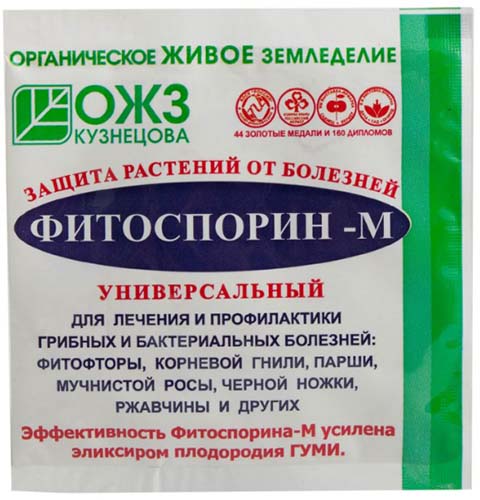
Note! As mentioned earlier, there are alsospecialized types of Fitosporin (Cabbage, Potatoes, Cucumbers, Tomatoes, Garden Flowers) which contain specially selected bacteria against specific diseases, as well as important trace elements for plant development.
Garden flowers
Sold in a package weighing 30 grams (powder).
Fitosporin-M "Garden Flowers" is used for the prevention and treatment of:
- powdery mildew;
- leaf spot;
- root rot.
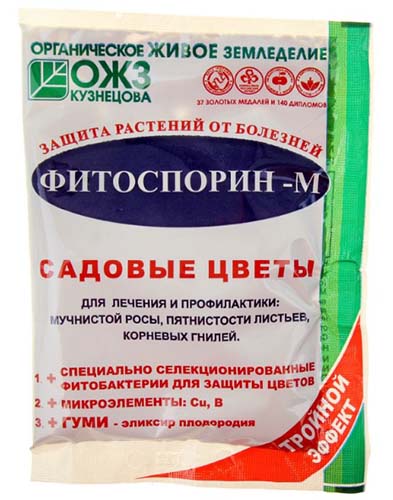
Note! Fitosporin-M "Garden Flowers" can be used for indoor flowers.
For cabbage
By the way! The drug is also suitable for other cruciferous plants - radish, turnip, radish, etc.
Fitosporin-M "Cabbage" is used for the prevention and treatment of:
- black leg;
- keels;
- powdery mildew;
- black, gray and wet rot;
- bacteriosis and other diseases.
Sold in a package weighing 10 grams (powder).
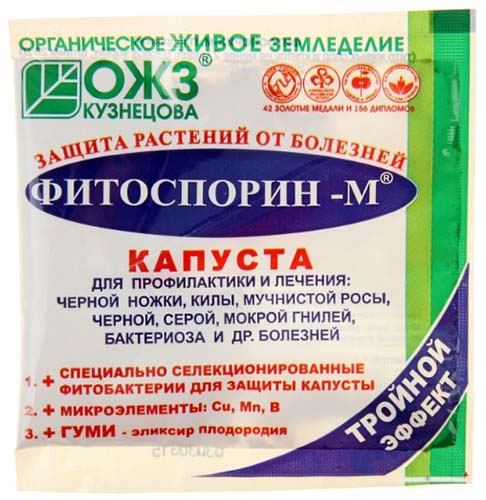
For potatoes
Sold in a package weighing 30 grams (powder).
Fitosporin-M "Potato" is used for the prevention and treatment of:
- alternaria;
- rhizoctonia;
- late blight;
- wilting;
- dry and wet rot of tubers and other diseases.
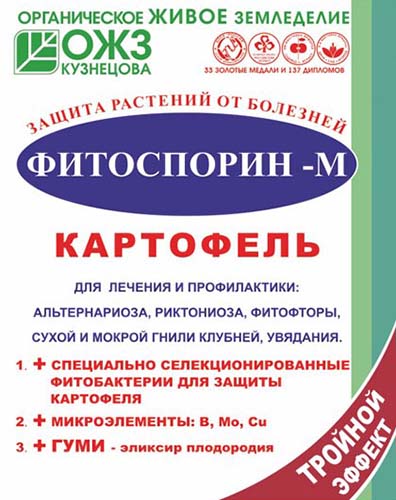
For cucumbers
By the way! The drug is also suitable for other melons - watermelon, melon, pumpkin, etc.
Fitosporin-M "Cucumbers" is used for the prevention and treatment of:
- powdery mildew;
- fusarium;
- wilting;
- root rot;
- leaf diseases;
- black leg and other diseases.
Sold in a package weighing 10 grams (powder).
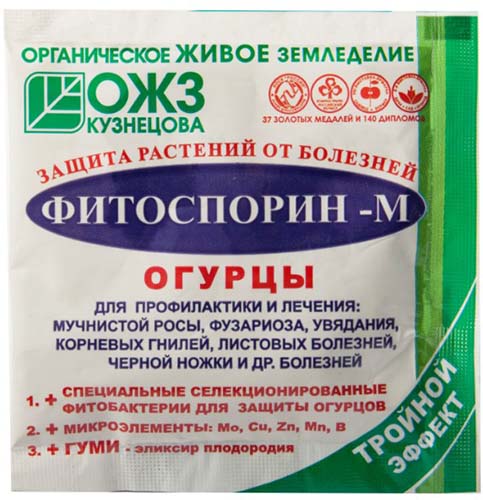
For tomatoes
By the way! The drug is also suitable for other nightshades - peppers, eggplants, physalis, etc.
Fitosporin-M "Tomatoes" is used for the prevention and treatment of:
- late blight;
- spotting;
- black leg;
- apical rot;
- wilting and other diseases.
Sold in a package weighing 10 grams (powder).
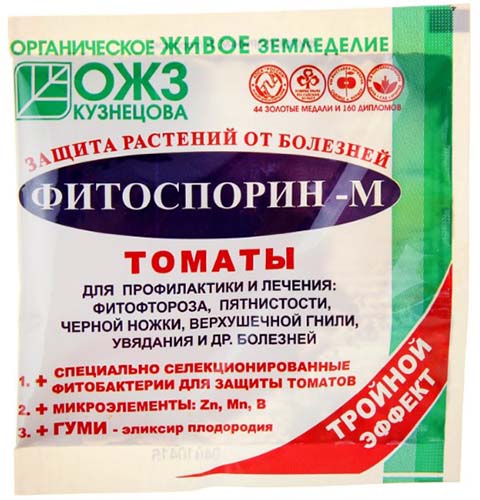
Video: Fitosporin-M "Tomatoes" - protection of tomatoes from black leg and late blight
How to prepare Fitosporin-M solution: instructions for use
As mentioned earlier, Fitosporin-M is available in the following 3 forms:
- powder (light white);
- in the form of a paste (dark color);
- liquid (smells like ammonia).
This means that the preparation of Fitosporin solutions will differ slightly from each other. But the methods of application, of course, are the same. We will also talk about them further.
By the way! The use of Fitosporin is very popular. for orchids, especially for their "salvation".
Video: Fitosporin-M for orchids - properties, dosage, solution preparation and its application
Fitosporin-M powder: how to prepare a solution and apply correctly
The most popular form of Fitosporin release.
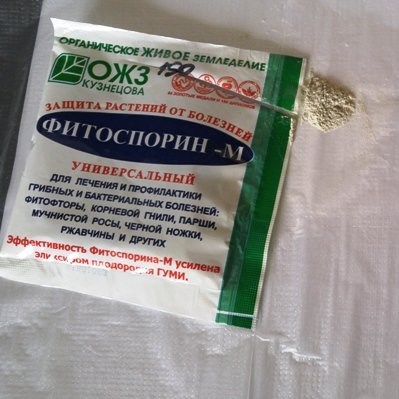
General tips and tricks for preparing Fitosporin-M "Universal" solution from powder:
- In 1 teaspoon - 3-3.5 grams of the product.
- It is advisable to use settled and soft water (including rain, thawed or filtered).
- The solution should be prepared (diluted with water) 1-2 hours before processing.
Advice! To get more bacteria, the solution can be made even earlier - in 24 hours.
- The water temperature can be from +15 to +35 degrees.
Although the bacteria Fitosporin, being in a spore form, tolerate a much greater temperature difference.
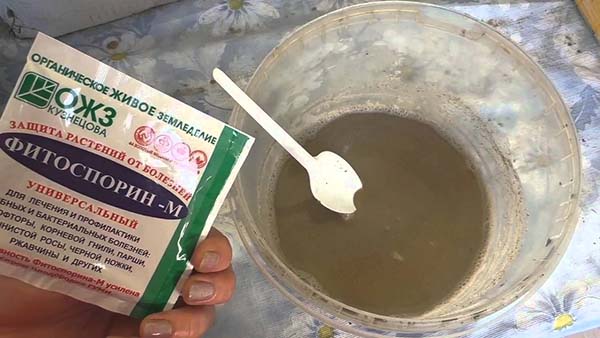
Concentration working solution of Fitosporin, prepared from powder, differsdepending on the purpose of use:
For soil disinfection
To prepare Fitosporin solutionfor soil disinfection before sowing seeds (or for soil treatment before planting seedlings), you need to dissolve 3-4 grams of powder in 10 liters of water, and then process 1 square meter.
For soaking seeds and tubers
To prepare Fitosporin solution for soaking seeds (cabbage, tomatoes, cucumbers, etc.), you will need to dissolve 1.5 grams of the product in 1 liter of water, and then soak the seeds (100 pieces in 100-150 ml of solution) for 1-2 hours.
By the way! Optionally, in Fitosporin solution you can germinate seedsby soaking for 12-24 hours.
Potato tubers processed in a more concentrated solution: 10 grams per 0.5 liters (per 20 kg).
For dipping the roots of seedlings before planting in the ground
To prepare Fitosporin solution for dipping the roots of cabbage seedlings before planting, you will need to dissolve 3 grams of the product in 1 liter of water, and then immerse the roots for 1-2 hours (1 liter per 100-150 plants). But for dipping roots tomato seedlings required less concentrated solution: 2 g per 1 liter of water will be enough.
For root watering
Instead of immersing the roots in the solution, seedlings tomato 3 days after planting in the ground, you can additionally shed (150-200 ml per plant), preparing a similar solution, as for dipping the roots (2 g per 1 liter).
Also under the root can watering sick garden flowers (3 g per 10 liters, 1 liter per plant) and houseplants (0.3 g per 10 liters, 100 ml per plant).
For spraying during the growing season
For spraying various crops during the growing season you will need to prepare solutions of different concentrations and carry out treatments at certain periods with the recommended frequency:
- Potatoes (10 grams of product per 5 liters) - prophylactic spraying in the phases of row closing - budding and again after 10-15 days (5 liters of solution for 50 square meters of beds).
- Cabbage (6 g per 10 liters) - 7-10 days after planting in open ground and again after 2-3 weeks (10 liters per 100 square meters).
- Tomatoes (5 g per 10 l) - 2 or more treatments with an interval of 10-15 days (10 liters per 100 sq. M).
- Cucumbers (10 g per 5 l) - 3 treatments with an interval of 10-15 days (5 l per 50 sq. M).
- Currants and roses (3 g per 10 l) - preventive spraying before flowering and after 10-15 days (10 l per 100 m2).
- Garden flowers (3 g per 10 l) - as needed (in case of illness) during the growing season (10 l per 100 sq. M).
- Houseplants (0.3 g per 10 l) - as needed (in case of illness) during the growing season.
Video: the use of "Fitosporin-M" in the form of powders
Fitosporin-M liquid: how to prepare a solution and apply correctly
Fitosporin in liquid form is no less popular.
Important! Fitosporin "Seedlings, Vegetables, Berries, Fruit" and "Flowers" applied for prevention diseases, preventing plant stress (especially during transplantation), and also perform the function of accelerating growth. Whereas Fitosporin "Reanimator" directly acts against diseases, in other words, it is used already specifically for the fight, and not for prevention... But Fitosporin "Golden autumn" more intended for storing the grown crop.
For seedlings, vegetables, berry bushes and fruit trees
Sold in a bottle of 110 ml.
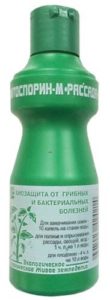
Fitosporin-M "Seedling, Vegetables, Berries, Fruit" is used for the biological protection of seedlings, vegetable crops, berry bushes and fruit trees from fungal and bacterial diseases:
- rot;
- black leg;
- fusarium;
- scab and other diseases.
Methods for preparing working solutions from liquid Fitosporin-M:
- For soaking seeds (tomatoes, cucumbers, eggplants, etc.) - 10 drops in 1 glass of water (200 ml).
Clarifying comment from the manufacturer: “You can soak until the seeds germinate. The exact time for different types of crops may vary. For example, for radishes it is 20 minutes, and for beets it is 12 hours. One more point - depending on which seeds you plan to sow - dry or swollen (up to seedlings). If there is no time, then sow with dry seeds. If there is time, then swollen. For example, for tomatoes and cucumbers, the soak time can be 1 hour. Then the seeds remain dry. Or 12 hours - then the seeds will be swollen.
- For immersing the roots of seedlings of plants and flowers - 1 teaspoon for 1 liter of water.
- For watering and spraying seedlings, vegetables, berry bushes - 1 teaspoon per 1 liter of water, and for fruit trees - 4 teaspoons per 1 liter of water.
Watering and spraying frequency: 1 time in 10-14 days for prevention. But it is possible more often, because it is a biological agent, in other words, it is safe for seedlings and plants.
For flowers
Sold in a bottle of 110 ml.
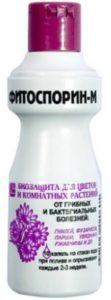
Fitosporin-M "Flowers" is used for bioprotection (prevention) of indoor plants and flowers from fungal and bacterial diseases:
- rot;
- fusarium;
- scab;
- wilting;
- rust and other diseases.
Method of preparation of working solution from liquid Fitosporin-M "Flowers":
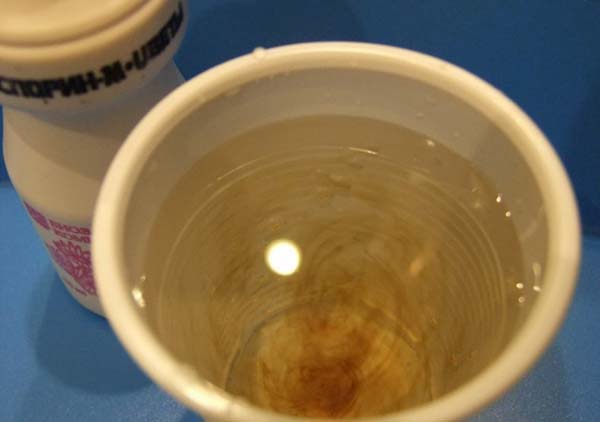
- 10 drops in a glass of water (200 ml) during pre-sowing soaking of seeds, as well as when watering and spraying indoor plants and flowers every 2-3 weeks.
Video: application of liquid Fitosporin-M "Seedling, Vegetables, Berries, Fruit" and "Flowers"
Reanimator
Sold in a 200 ml bottle.
Fitosporin-M "Reanimator" is used as an "ambulance" if you have not performed preventive treatments and the plant has contracted a fungal or bacterial disease.

"Reanimator" is effective against the following diseases:
- powdery mildew;
- late blight (for example, tomato or potatoes);
- black leg;
- fusarium;
- rust;
- scab;
- gray rot;
- bacteriosis and other diseases.
In other words, it is intended to combat the already secondary stages of the diseaseso to speak with severe and neglected consequences (plaque, spots, leaf dieback, stem or root decay appeared).
The concentration of a solution of liquid Fitosporin-M "Reanimator" depends on the degree of damage to plants:
- With an average degree - dilute the drug in a ratio of 1 to 20 (0.2 l in 4 liters of water), spray, consuming 1 liter per 10 sq. M.
- With a high degree - dilute the drug in a ratio of 1 to 2 (0.2 l in 0.4 liters of water), spray, consuming 1 liter per 10 sq. M.
Frequency rate of treatments: 2-3 times or more with an interval of 2 days.
Video: application of the biological product Fitosporin-M "Reanimator"
Golden autumn
Sold in a 200 ml bottle.

Fitosporin-M "Golden Autumn" can be used for:
- Processing plants and fruits before, during and after harvest (to protect against diseases during growth and storage);
- Treatment (disinfection) of storage facilities, cellars, refrigerators, containers, vehicles for transporting agricultural products;
- Processing before storage and before long-term transportation of beets, onions and other vegetable and fruit products.
- Application to the soil in spring and autumn after harvest, which allows improve the soil and reduce the level of infection, and in greenhouses - do not steam, disinfect or replace the soil;
Advice! Also, this tool can heal the soil for growing seedlings.
To prepare a working solution of Fitosporin "Golden Autumn", depending on the purpose, you need:
- To improve (disinfect) the soil— dissolve 1 teaspoon in 10 liters of water.Spill the soil, spending 10 liters for 2 sq. meters.
- For processing vegetables and fruits before storage - dilute 50 ml (2 caps) in 0.5 liters of water. Spray 50 kg of product. Put in storage after drying.
Important! Processed vegetables and fruits can be eaten on the day of processing.
- For spraying a cellar or other storage location - dissolve 200 ml of the drug (the whole bottle) in 0.8 liters of water. Carry out processing of a room of 100 square meters.
Video: application of liquid "Fitosporin-M Reanimator" and "Golden Autumn"
Fitosporin-M paste: how to prepare a solution and apply correctly
Fitosporin in the form of a paste is:
- Universal - 200 g.
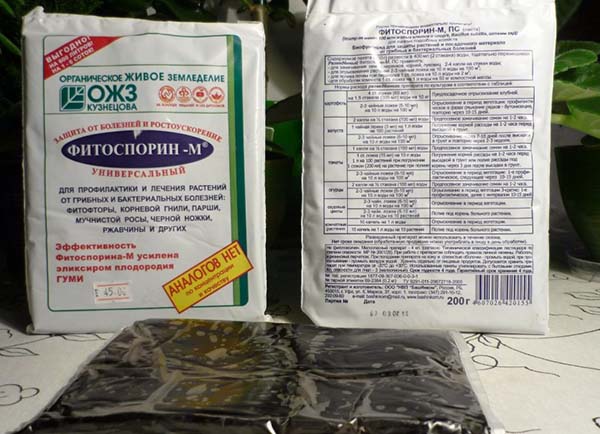
- Super-Universal Instant - 100 g.
- Instant Tomatoes - 100 g.
- Instant Potatoes - 100 g.
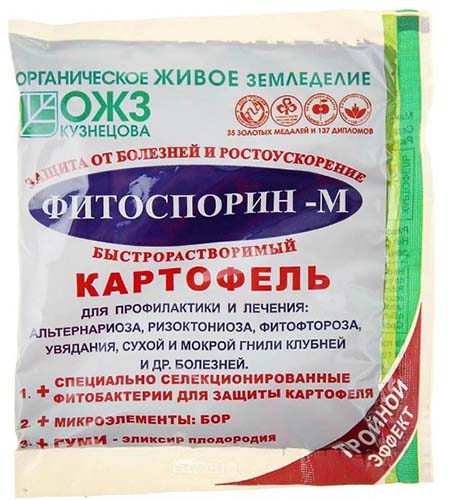
Specialized types of Fitosporin in the form of a paste "Tomatoes" and "Potatoes" contain specially selected (selected) bacteria against specific diseases, as well as important trace elements.
To prepare Stock solution Fitosporin from paste need to:
- The contents of the package (100 grams) are thoroughly diluted in 200 ml (1 cup) of water (or 200 grams in 2 glasses or 400 ml).
Advice! To dilute the paste, you can take any water, but it is better to have settled and soft water (including rain, thawed or filtered), not only hot.
Further from mother liquor need to get working solutions Fitosporin for different purposes:
For soaking seeds and tubers
To prepare Fitosporin solution for soaking seeds cabbage and cucumbers, You will need to dissolve 2 drops of the product in 1/2 cup (100 ml) of water, and then soak the seeds (100 per 100 solution) for 1-2 hours.
Tomato seeds should be soaked in a less concentrated solution - 1 drop in 1/2 cup (100 ml) of water.
By the way! Optionally, in Fitosporin solution you can germinate seedsby soaking for a longer time (12-24 hours).
Potato tubers processed in a more concentrated solution: 4 tbsp. spoons (60 ml) for 1.5 cups (300 ml) of water (for 10 kg).
For dipping the roots of seedlings before planting in the ground
To prepare Fitosporin solution for dipping the roots of cabbage seedlings before planting, you will need to dissolve 1 teaspoon (3 ml) of the product in 1 liter of water. Then immerse the roots for 1-2 hours (1 liter per 100-150 plants). But for dipping roots tomato seedlings required less concentrated solution - 1/2 teaspoon (1.5 ml) per 1 liter of water will be enough, or 1 tbsp. spoon (15 ml) for 10 liters of water.
For root watering
Instead of immersing the roots in the solution, seedlings tomato 3 days after planting in the ground, you can additionally shed (200 ml per plant), having prepared a similar solution, as for dipping the roots, - 1/2 teaspoon (1.5 ml) of the product per 1 liter or 1 tbsp. spoon (15 ml) for 10 liters of water.
Also under the root can watering sick garden flowers - 2-3 teaspoons (6-10 ml) per 10 liters per 100 sq. meters and houseplants - 15 drops per 1 liter and 100 ml per plant.
For spraying during the growing season
For spraying various crops during the growing season you will need to prepare solutions of different concentrations and carry out treatments at certain periods with the recommended frequency:
- Potatoes (2-3 teaspoons (6-10 ml) per 10 liters and per 100 square meters) - the first preventive spraying in the phases of closing the rows - budding and again after 10-15 days.
- Cabbage (2-3 teaspoons (6-10 ml) per 10 liters and per 100 square meters) - 7-10 days after planting in open ground and again after 2-3 weeks.
- Tomatoes (2-3 teaspoons (6-10 ml) per 10 liters and per 100 square meters) - 2 or more treatments with an interval of 10-15 days.
- Cucumbers (2-3 teaspoons (6-10 ml) per 10 liters and per 100 square meters - 3 treatments with an interval of 10-15 days.
- Garden flowers (2-3 teaspoons (6-10 ml) per 10 liters and per 100 square meters) - as needed (in case of illness) during the growing season (10 liters per 100 square meters) every 10-15 days.
- Houseplants (10 drops per 1 liter of water) - as needed (in case of illness) during the growing season.
For watering the soil when digging and composting
To prepare Fitosporin solution for soil disinfection when digging, you need to dissolve 1 tbsp. spoon (15 ml) of the product (stock solution) in 10 liters of water, and then process 2 square meters.
To accelerate the maturation of compost - you need to dissolve 1 tbsp. spoon (15 ml) of the product in 1 liter of water, and then process 50 kg of compost mass.
Video: the use of Fitosporin-M in the form of a paste
Can Fitosporin be mixed with other remedies
To save time, any gardener and gardener wants to spend a minimum of time and effort and get the maximum result by mixing several remedies at once (by preparing a tank mixture), carrying out a one-time treatment of plants from all diseases and pests.
By the way! According to the manufacturer, Fitosporin compatible with any organic and mineral fertilizers.
It is better not to mix biological remedies with each other.since a situation may occur when one bacterium begins to suppress another, which means that the effectiveness of each of the means will noticeably decrease.
For example, according to the specialist of the Procvetok channel, do not use Fitosporin and Trichodermin togethersince the bacteria in the composition will begin to suppress each other.However, you you can use both, eg, watering the soil with Trichodermin solution, and Fitosporin - the aerial part of the plant. Lfor, alternatively by doing processing at intervals of 2-3 weeks.
Interesting! However, the manufacturer claims the opposite: "Fitosporin bacteria do not have antagonism to plant-friendly microflora, including Trichoderma."
Video: is it possible to mix different remedies or "tank mixtures - drug compatibility"
Precautions when working with the drug
- The hazard class for humans is 3B. Slightly irritating to the mucous membrane of the eye (moderately dangerous drug).
- When working, use personal protective equipment and observe the rules of personal hygiene.
- In case of contact with skin and mucous membranes, rinse with water, if swallowed, rinse the stomach with water.
- Dispose of used bags together with household waste.
- Not phytotoxic. Hazard class for bees - 3 (low hazard).
- No waiting period (products can be eaten on the day of processing).
By the way! The manufacturer's website says that Fitosporin is completely safe: today you have processed the plant (sprayed, watered, applied to the soil or sprayed with fruits to improve storage), and today you can use both leaves and plant fruits for food. "
Conditions and shelf life of the drug
Important! The shelf life of the drug in any form (powder, paste and liquid) is 4 years.
Storage temperature in the form of powder - + 20 ... 30 degrees, in liquid form - + 5 ... 25 degrees.
Store away from food.
Answers to popular questions about the conditions and shelf life of the drug:
Can paste stock solution be stored?
Fitosporin in the form of a paste contains a high concentration of humates, which prevent bacteria from leaving the spores in the mother solution, so it can be stored for a long time (during the season). Moreover, it is better to store the solution in a cool and dark place, at a temperature not higher than +25, tightly closed. Be sure to protect from direct sunlight.
By the way! If the stock solution is frozen, then it can be used after thawing. The main thing is to mix well before use, because stratification into fractions occurs.
Can a solution made from powder be stored?
There is no such humate content in Fitosporin powder, therefore, diluted Fitosporin (in powder form) can be stored for no more than 2 days, and in a cool and dark place, and it is better to use it within 24 hours.
Can Fitosporin be used if the expiration date has expired?
You can use it, there is no danger in this, just after the expiration date the titer of microorganisms (the number of living beneficial bacteria per unit volume) begins to gradually fall. Increase the dose a little and use it to your health!
Note! All answers from the manufacturer are found in the comments to the video instructions.
Thus, now you know for sure that Fitosporin is a truly indispensable assistant in the garden, vegetable garden and even on the windowsill. Preparing a solution for processing is as easy as shelling pears, but what is the use for plants.
Video: Fitosporin - protecting plants from diseases

